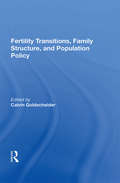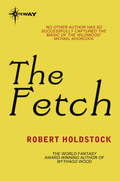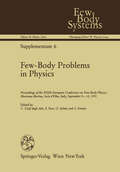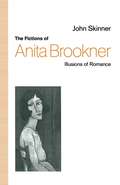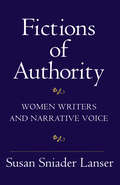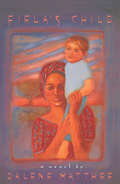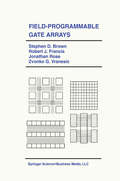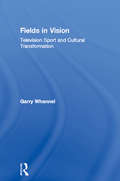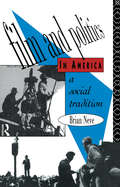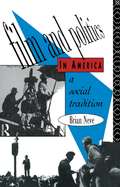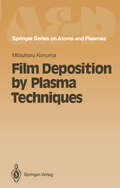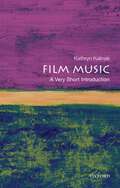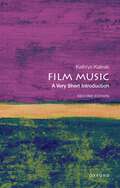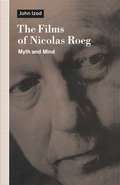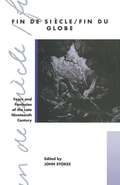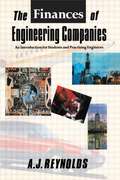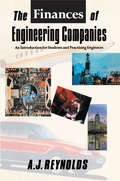- Table View
- List View
Fertility Transitions, Family Structure, And Population Policy
by Calvin GoldscheiderFocuses on fertility and family transitions in selected Third World countries, exploring critical aspects of the relationship between population and development. The essays examine population processes as they unfold and develop over time, highlighting the need to go beyond economic explanations and identifying the priorities among social structura
Fertility Transitions, Family Structure, And Population Policy
by Calvin GoldscheiderFocuses on fertility and family transitions in selected Third World countries, exploring critical aspects of the relationship between population and development. The essays examine population processes as they unfold and develop over time, highlighting the need to go beyond economic explanations and identifying the priorities among social structura
The Fetch
by Robert HoldstockThere is a landscape between reality and dreams, a strange and primitive country that exists upon the edge of our waking world. Michael Whitlock knows that country well. His best friend lives there...It beings with a scatter of earth, thrown over the infant by unseen hands, a haunting attack that is repeated day after day, culminating with an explosive fall of mud that nearly kills the boy. And found in those tons of raw, wet earth: flints, chalk artefacts, and remains of a primitive shrine and the dismembered carcase of a hunting dog.The Whitlocks' house, in the Kentish Weald, stands near a chalk-pit, and it is here that their son, Michael creates his preculiar imaginary world, making his camp by the pile of grave-earth from that early attack. Unaware of what is happening to him, the boy touches and uses the strange force that now ebbs and flows in the pit, And when the haunting returns, this time it is more subtle, almost wonderful in its secutive nature. Torn between a fear of the supernatural and greed for the results of Michael's power, his adoptive parents are helpless. It is left to Françoise Jeury, a psyhic investigator, to piece together the bizarre truth of th epit and the shrine and the oddly silent boy.
Few-Body Problems in Physics: Proceedings of the XIIIth European Conference on Few-Body Physics, Marciana Marina, Isola d’Elba, Italy, September 9–14, 1991 (Few-Body Systems #6)
by Claudio Ciofi Degli Atti Emanuele Pace Giovanni Salme Silvano SimulaThe Fictions of Anita Brookner: Illusions of Romance
by John Skinner Skye ClearyThe Fiction of Anita Brookner is the first full-length study of this controversial contemporary writer. After discussing critical assessments of Brookner, and attempts to relate her to various classics and contemporaries, Dr Skinner skilfully combines insights from recent narrative theory with close analyses of nine novels. Moving from the first novels, and their close relations to French literary models, he goes on to trace the increased sophistication of Hotel du Lac and the technical innovations of its successors.
Fictions of Authority: Women Writers and Narrative Voice
by Susan Sniader LanserDrawing on narratological and feminist theory, Susan Sniader Lanser explores patterns of narration in a wide range of novels by women of England, France, and the United States from the 1740s to the present. She sheds light on the history of "voice" as a narrative strategy and as a means of attaining social power. She considers the dynamics in personal voice in authors such as Mary Shelley, Charlotte Brontë, Zora Neale Hurston, and Jamaica Kincaid. In writers who attempt a "communal voice"—including Mary Wollstonecraft, Elizabeth Gaskell, Joan Chase, and Monique Wittig—she finds innovative strategies that challenge the conventions of Western narrative.
Fiela's Child (Phoenix Fiction)
by Dalene MattheeSet in nineteenth-century rural Africa, Fiela's Child tells the gripping story of Fiela Komoetie and a white, three-year old child, Benjamin, whom she finds crying on her doorstep. For nine years Fiela raises Benjamin as one of her own children. But when census takers discover Benjamin, they send him to an illiterate white family of woodcutters who claim him as their son. What follows is Benjamin's search for his identity and the fundamental changes affecting the white and black families who claim him. "Everything a novel can be: convincing, thought-provoking, upsetting, unforgettable, and timeless."—Grace Ingoldby, New Statesman "Fiela's Child is a parade that broadens and humanizes our understanding of the conflicts still affecting South Africa today."—Francis Levy, New York Times Book Review "A powerful creation of time and place with dark threads of destiny and oppression and its roots in the almost Biblical soil of a storyteller's art."—Christopher Wordsworth, The Guardian "The characters in the novel live and breathe; and the landscape is so brightly painted that the trees, birds, elephants, and rivers of old South Africa are characters themselves. A book not to miss."—Kirkus Reviews
Fiela's Child (Phoenix Fiction)
by Dalene MattheeSet in nineteenth-century rural Africa, Fiela's Child tells the gripping story of Fiela Komoetie and a white, three-year old child, Benjamin, whom she finds crying on her doorstep. For nine years Fiela raises Benjamin as one of her own children. But when census takers discover Benjamin, they send him to an illiterate white family of woodcutters who claim him as their son. What follows is Benjamin's search for his identity and the fundamental changes affecting the white and black families who claim him. "Everything a novel can be: convincing, thought-provoking, upsetting, unforgettable, and timeless."—Grace Ingoldby, New Statesman "Fiela's Child is a parade that broadens and humanizes our understanding of the conflicts still affecting South Africa today."—Francis Levy, New York Times Book Review "A powerful creation of time and place with dark threads of destiny and oppression and its roots in the almost Biblical soil of a storyteller's art."—Christopher Wordsworth, The Guardian "The characters in the novel live and breathe; and the landscape is so brightly painted that the trees, birds, elephants, and rivers of old South Africa are characters themselves. A book not to miss."—Kirkus Reviews
Fiela's Child (Phoenix Fiction)
by Dalene MattheeSet in nineteenth-century rural Africa, Fiela's Child tells the gripping story of Fiela Komoetie and a white, three-year old child, Benjamin, whom she finds crying on her doorstep. For nine years Fiela raises Benjamin as one of her own children. But when census takers discover Benjamin, they send him to an illiterate white family of woodcutters who claim him as their son. What follows is Benjamin's search for his identity and the fundamental changes affecting the white and black families who claim him. "Everything a novel can be: convincing, thought-provoking, upsetting, unforgettable, and timeless."—Grace Ingoldby, New Statesman "Fiela's Child is a parade that broadens and humanizes our understanding of the conflicts still affecting South Africa today."—Francis Levy, New York Times Book Review "A powerful creation of time and place with dark threads of destiny and oppression and its roots in the almost Biblical soil of a storyteller's art."—Christopher Wordsworth, The Guardian "The characters in the novel live and breathe; and the landscape is so brightly painted that the trees, birds, elephants, and rivers of old South Africa are characters themselves. A book not to miss."—Kirkus Reviews
Fiela's Child (Phoenix Fiction)
by Dalene MattheeSet in nineteenth-century rural Africa, Fiela's Child tells the gripping story of Fiela Komoetie and a white, three-year old child, Benjamin, whom she finds crying on her doorstep. For nine years Fiela raises Benjamin as one of her own children. But when census takers discover Benjamin, they send him to an illiterate white family of woodcutters who claim him as their son. What follows is Benjamin's search for his identity and the fundamental changes affecting the white and black families who claim him. "Everything a novel can be: convincing, thought-provoking, upsetting, unforgettable, and timeless."—Grace Ingoldby, New Statesman "Fiela's Child is a parade that broadens and humanizes our understanding of the conflicts still affecting South Africa today."—Francis Levy, New York Times Book Review "A powerful creation of time and place with dark threads of destiny and oppression and its roots in the almost Biblical soil of a storyteller's art."—Christopher Wordsworth, The Guardian "The characters in the novel live and breathe; and the landscape is so brightly painted that the trees, birds, elephants, and rivers of old South Africa are characters themselves. A book not to miss."—Kirkus Reviews
Field-Programmable Gate Arrays (The Springer International Series in Engineering and Computer Science #180)
by Stephen D. Brown Robert J. Francis Jonathan Rose Zvonko G. VranesicField-Programmable Gate Arrays (FPGAs) have emerged as an attractive means of implementing logic circuits, providing instant manufacturing turnaround and negligible prototype costs. They hold the promise of replacing much of the VLSI market now held by mask-programmed gate arrays. FPGAs offer an affordable solution for customized VLSI, over a wide variety of applications, and have also opened up new possibilities in designing reconfigurable digital systems. Field-Programmable Gate Arrays discusses the most important aspects of FPGAs in a textbook manner. It provides the reader with a focused view of the key issues, using a consistent notation and style of presentation. It provides detailed descriptions of commercially available FPGAs and an in-depth treatment of the FPGA architecture and CAD issues that are the subjects of current research. The material presented is of interest to a variety of readers, including those who are not familiar with FPGA technology, but wish to be introduced to it, as well as those who already have an understanding of FPGAs, but who are interested in learning about the research directions that are of current interest.
Fields in Vision: Television Sport and Cultural Transformation (Communication and Society)
by Garry WhannelFields in Vision offers a comprehensive and analytical study of the international phenomenon of television sports coverage. Garry Whannel considers the historical development of sport on television, the growth of sponsorship and the way that television and sponsorship have re-shaped sport in the context of the enterprise culture. Drawing on archival research, Whannel first charts the development of the BBC Outside Broadcast department, and the growing battle for dominance between BBC and ITV, showing how sponsorship and the rising power of sports agents began to transform sport - not only in the UK but across the world - in the 1960s. He goes on to examine the implications of this vast and escalating global network during the 1980s by analysing the central role that stars and narratives began to play in television sport, presenting case studies of major contests such as Coe versus Ovett and Decker versus Budd. His study also takes into account one of the more indirect, but no less significant results of international televised sport - the rise of popular fitness chic and the American monopoly of the workout boom of the 1980s. Fields in Vision explains the development of television sport by linking its economic transformation with the cultural forms through which it is represented, offering a study encompassing not simply the sports world, but our relationship with television and the media industries as a whole.
Fields in Vision: Television Sport and Cultural Transformation (Communication and Society)
by Garry WhannelFields in Vision offers a comprehensive and analytical study of the international phenomenon of television sports coverage. Garry Whannel considers the historical development of sport on television, the growth of sponsorship and the way that television and sponsorship have re-shaped sport in the context of the enterprise culture. Drawing on archival research, Whannel first charts the development of the BBC Outside Broadcast department, and the growing battle for dominance between BBC and ITV, showing how sponsorship and the rising power of sports agents began to transform sport - not only in the UK but across the world - in the 1960s. He goes on to examine the implications of this vast and escalating global network during the 1980s by analysing the central role that stars and narratives began to play in television sport, presenting case studies of major contests such as Coe versus Ovett and Decker versus Budd. His study also takes into account one of the more indirect, but no less significant results of international televised sport - the rise of popular fitness chic and the American monopoly of the workout boom of the 1980s. Fields in Vision explains the development of television sport by linking its economic transformation with the cultural forms through which it is represented, offering a study encompassing not simply the sports world, but our relationship with television and the media industries as a whole.
Film And Politics In America: A Social Tradition
by Brian NeveA study of the relationship between American film and American politics and society, by examining directors such as Orson Welles, Elia Kazan and Jules Dassin.
Film And Politics In America: A Social Tradition (PDF)
by Brian NeveA study of the relationship between American film and American politics and society, by examining directors such as Orson Welles, Elia Kazan and Jules Dassin.
Film and Politics in America: A Social Tradition
by Brian NeveIn A Social Cinema: Film-making and Politics in America, Brian Neve presents a study of the social and political nature of American film by concentrating on a generation of writers from the thirties who directed films in Hollywood in the 1940's. He discusses how they negotiated their roles in relation to the studio system, itself undergoing change, and to what extent their experience in the political and theatre movements of thirties New York was to be reflected in their later films.Focusing in particular on Orson Welles, Elia Kazan, Jules Dassin, Abraham Polonsky, Nicholas Ray, Robert Rossen and Joseph Losey, Neve relates the work of these writers and directors to the broader industrial, bureaucratic, social and political developments of the period 1935-1970. With special emphasis on the post-war decade, bringing together archive and secondary sources, Neve explores a lost tradition of social fimmaking in America.
Film and Politics in America: A Social Tradition (Studies In Film, Television And The Media Ser.)
by Brian NeveIn A Social Cinema: Film-making and Politics in America, Brian Neve presents a study of the social and political nature of American film by concentrating on a generation of writers from the thirties who directed films in Hollywood in the 1940's. He discusses how they negotiated their roles in relation to the studio system, itself undergoing change, and to what extent their experience in the political and theatre movements of thirties New York was to be reflected in their later films.Focusing in particular on Orson Welles, Elia Kazan, Jules Dassin, Abraham Polonsky, Nicholas Ray, Robert Rossen and Joseph Losey, Neve relates the work of these writers and directors to the broader industrial, bureaucratic, social and political developments of the period 1935-1970. With special emphasis on the post-war decade, bringing together archive and secondary sources, Neve explores a lost tradition of social fimmaking in America.
Film Deposition by Plasma Techniques (Springer Series on Atomic, Optical, and Plasma Physics #10)
by Mitsuharu KonumaProperties of thin films depend strongly upon the deposition technique and conditions chosen. In order to achieve the desired film, optimum deposition conditions have to be found by carrying out experiments in a trial-and error fashion with varying parameters. The data obtained on one growth apparatus are often not transferable to another. This is especially true for film deposition processes using a cold plasma because of our poor under standing of the mechanisms. Relatively precise studies have been carried out on the role that physical effects play in film formation such as sputter deposition. However, there are many open questions regarding processes that involve chemical reactions, for example, reactive sputter deposition or plasma enhanced chemical vapor deposition. Much further research is re quired in order to understand the fundamental deposition processes. A sys tematic collection of basic data, some of which may be readily available in other branches of science, for example, reaction cross sections for gases with energetic electrons, is also required. The need for pfasma deposition techniques is felt strongly in industrial applications because these techniques are superior to traditional thin-film deposition techniques in many ways. In fact, plasma deposition techniques have developed rapidly in the semiconductor and electronics industries. Fields of possible application are still expanding. A reliable plasma reactor with an adequate in situ system for monitoring the deposition conditions and film properties must be developed to improve reproducibility and pro ductivity at the industrial level.
Film Music: Music And The Classical Hollywood Film (Wisconsin Studies In Film Ser.)
by Kathryn KalinakFilm Music: Music And The Classical Hollywood Film (Very Short Int)
by Kathryn KalinakFilm music is as old as cinema itself. Years before synchronized sound became the norm, projected moving images were shown to musical accompaniment, whether performed by a lone piano player or a hundred-piece orchestra. Today film music has become its own industry, indispensable to the marketability of movies around the world. Film Music: A Very Short Introduction is a compact, lucid, and thoroughly engaging overview written by one of the leading authorities on the subject. After opening with a fascinating analysis of the music from a key sequence in Quentin Tarantino's Reservoir Dogs, Kathryn Kalinak introduces readers not only to important composers and musical styles but also to modern theoretical concepts about how and why film music works. Throughout the book she embraces a global perspective, examining film music in Asia and the Middle East as well as in Europe and the United States. Key collaborations between directors and composers--Alfred Hitchcock and Bernard Herrmann, Akira Kurosawa and Fumio Hayasaka, Federico Fellini and Nino Rota, to name only a few--come under scrutiny, as do the oft-neglected practices of the silent film era. She also explores differences between original film scores and compilation soundtracks that cull music from pre-existing sources. As Kalinak points out, film music can do many things, from establishing mood and setting to clarifying plot points and creating emotions that are only dimly realized in the images. This book illuminates the many ways it accomplishes those tasks and will have its readers thinking a bit more deeply and critically the next time they sit in a darkened movie theater and music suddenly swells as the action unfolds onscreen. About the Series: Combining authority with wit, accessibility, and style, Very Short Introductions offer an introduction to some of life's most interesting topics. Written by experts for the newcomer, they demonstrate the finest contemporary thinking about the central problems and issues in hundreds of key topics, from philosophy to Freud, quantum theory to Islam.
Film Music: Music And The Classical Hollywood Film (VERY SHORT INTRODUCTIONS)
by Kathryn KalinakThe rich and deeply moving sounds of film music are as old as cinema. The first projected moving images were accompanied by music through a variety of performers--from single piano players to small orchestras--that brought images to life. Film music has since become its own industry, an aesthetic platform for expressing creative visions, and a commercial vehicle for growing musical stars of all varieties. In this Very Short Introduction, Kathryn Kalinak takes readers behind the scenes to understand both the practical aspects of film music--what it is and how it is composed--and the theories that have been developed to explain why film music works. This accessible book not only entertains with the fascinating stories of the composers and performers who have shaped film music across the globe but also gives readers a broad sense of the key questions in film music studies today. The updated second edition includes the music from film industries in Africa, Asia and South Asia, and Latin America, and focuses on previously under-represented film musicians, in particular women and minority composers.
Films of Nicholas Roeg: Myth and Mind
by John IzodAudiences respond to three things in the films of Nicolas Roeg, their power, their style and the fact that they puzzle them. The author argues that all three elements are tied together, with the power of the films springing from their source in ancient mysteries.
Fin de Sicle/Fin du Globe: Fears and Fantasies of the Late Nineteenth Century (Warwick Studies in the European Humanities)
by John StokesThe internationally distinguished scholars who have contributed to this timely book were asked to take part in a collaborative act of demystification: a reconsideration of the eschatological ideas of the last fin de sicle, the 1890s, in the light of the critical thought of the 1990s. Their essays draw upon a range of approaches, and are broadly interdisciplinary. All are characterised by the realisation that, with a century's hindsight, the late 1800s should be seen not so much as a period of decadence as of discovery and growth.
The Finances Of Engineering Companies
by A. J. ReynoldsStudents from all engineering disciplines, as well as professional engineers, need to understand company finance in order to work effectively within commercial organisations. Corporate finance is therefore an essential aspect of the education of every engineer. Written by an engineer, this innovative book provides a course in company finance, illustrated with numerous case studies of well-known engineering companies - including Rolls Royce, ICI, British Aerospace, Ferranti, Ford, Glaxo, GEC, British Steel, PowerGen and others. General principles are related to the affairs of specific companies, thus giving an effective overview for the busy engineer.
The Finances of Engineering Companies
by Alan James ReynoldsStudents from all engineering disciplines, as well as professional engineers, need to understand company finance in order to work effectively within commercial organisations. Corporate finance is therefore an essential aspect of the education of every engineer. Written by an engineer, this innovative book provides a course in company finance, illustrated with numerous case studies of well-known engineering companies - including Rolls Royce, ICI, British Aerospace, Ferranti, Ford, Glaxo, GEC, British Steel, PowerGen and others. General principles are related to the affairs of specific companies, thus giving an effective overview for the busy engineer.
